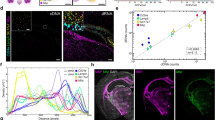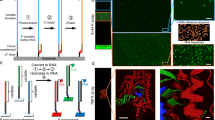Abstract
DNA microarrays have been used to study the expression of thousands of genes at the same time in a variety of cells and tissues1,2,3. The methods most commonly used to label probes for microarray studies require a minimum of 20 μg of total RNA or 2 μg of poly(A) RNA4,5. This has made it difficult to study small and rare tissue samples. RNA amplification techniques and improved labeling methods have recently been described6,7,8,9. These new procedures and reagents allow the use of less input RNA, but they are relatively time-consuming and expensive. Here we introduce a technique for preparing fluorescent probes that can be used to label as little as 1 μg of total RNA. The method is based on priming cDNA synthesis with random hexamer oligonucleotides, on the 5′ ends of which are bases with free amino groups. These amine-modified primers are incorporated into the cDNA along with aminoallyl nucleotides, and fluorescent dyes are then chemically added to the free amines. The method is simple to execute, and amine-reactive dyes are considerably less expensive than dye-labeled bases or dendrimers.
This is a preview of subscription content, access via your institution
Access options
Subscribe to this journal
Receive 12 print issues and online access
$209.00 per year
only $17.42 per issue
Buy this article
- Purchase on Springer Link
- Instant access to full article PDF
Prices may be subject to local taxes which are calculated during checkout


Similar content being viewed by others
References
DeRisi, J. et al. Use of a cDNA microarray to analyse gene expression patterns in human cancer. Nat. Genet. 14, 457–460 (1996).
Heller, R.A. et al. Discovery and analysis of inflammatory disease–related genes using cDNA microarray. Proc. Natl. Acad. Sci. USA 94, 2150–2155 (1997).
Wen, X. et al. Large-scale temporal gene expression mapping of central nervous system development. Proc. Natl. Acad. Sci. USA 95, 334–339 (1998).
Schena, M., Shalon, D., Davis, R.W. & Brown, P.O. Quantitative monitoring of gene expression patterns with a complementary DNA microarray. Science 270, 467–470 (1995).
Duggan, D., Bitter, M., Chen, Y., Meltzer, P. & Trent, J. Expression profiling using cDNA microarrays. Nat. Genet. Suppl. 21, 10–14 (1999)
Wang, E., Miller, L.D., Ohnmacht, G.A., Liu, E.T. & Marincola, F.M. High-fidelity mRNA amplification for gene profiling. Nat. Biotechnol. 18, 457–459 (2000).
Stears, R.L., Getts, R.C. & Gullans, S.R. A novel, sensitive detection system for high-density microarrays using dendrimer technology. Physiol. Genomics 3, 93–99 (2000).
Baelde, H.J. et al. High quality RNA isolation from tumors with low cellularity and high extracellular matrix component for cDNA microarrays: application to chondrosarcoma. J. Clin. Pathol. 54, 778–782 (2001).
Wong, K.-K., Cheng, R.S. & Mok, S.C. Identification of differentially expressed genes from ovarian cancer cells by MICROMAX cDNA microarray system. Biotechniques 30, 670–675 (2001).
Eisen, M.B. & Brown, P.O. DNA arrays for analysis of gene expression. Methods Enzymol. 303, 179–205 (1999).
Lashkari, D.A. et al. Yeast microarrays for genome wide parallel genetic and gene expression analysis. Proc. Natl. Acad. Sci. USA 94, 13057–13062 (1997).
Nimmakayalu, M., Henegariu, O., Ward, D.C. & Bray-Ward, P. Simple method for preparation of fluor/hapten-labeled dUTP. Biotechniques 28, 518–522 (2000).
Stanford University School of Medicine, Brown lab. The MGuide. http://cmgm.stanford.edu/pbrown/mguide/index.html.
National Human Genome Research Institute Division of Intramural Research. Microarray Project (uAP). http://www.nhgri.nih.gov/DIR/Microarray/main.html.
The University of Iowa. BMAP Project. http://brainest.eng.uiowa.edu.
Chen, Y., Dougherty, E.R. & Bittner, M.L. Ratio-based decisions and the quantitative analysis of cDNA microarray images. Biomedical Optics 2, 364–374 (1997).
Chen, Y. et al. Ratio statistics of gene expression levels and applications to microarray data analysis. Bioinformatics, in press (2002).
Acknowledgements
This project was partly supported by federal funds from the National Cancer Institute, National Institutes of Health, under contract number NO1-CO-12400. The content of this publication does not necessarily reflect the views or policies of the Department of Health and Human Services, nor does mention of trade names, commercial products, or organizations imply endorsement by the US government.
Author information
Authors and Affiliations
Corresponding author
Ethics declarations
Competing interests
The US Department of Health and Human Services has applied to patent the labeling method described in this manuscript. The patent is entitled, “Amine modified random primers for microarray detection.”
Rights and permissions
About this article
Cite this article
Xiang, C., Kozhich, O., Chen, M. et al. Amine-modified random primers to label probes for DNA microarrays. Nat Biotechnol 20, 738–742 (2002). https://doi.org/10.1038/nbt0702-738
Received:
Accepted:
Issue Date:
DOI: https://doi.org/10.1038/nbt0702-738
This article is cited by
-
Mechanistic analysis of a synthetic inhibitor of the Pseudomonas aeruginosa LasI quorum-sensing signal synthase
Scientific Reports (2015)
-
Characterisation of insulin-resistant phenotype of cultured rat primary adipose cells
Diabetologia (2007)
-
Molecular Analysis of the Magnocellular Neuroendocrine Phenotype: from the Micropunch to Laser Microdissection
Neurochemical Research (2006)



